Acquiring Anatomy Education through YouTube: Prospects and Challenges
© 2024 Mayaki Esther Oluwatoyin, Nwanama Emmanuel Kenechukwu, et al. This is an open-access article distributed under the terms of the Creative Commons Attribution License, which permits unrestricted use, distribution, and reproduction in any medium, provided the original author and source are credited.
Abstract
ABSTRACT
Background: Many students in Nigeria engage with the YouTube APP for learning purposes. This study is aimed at exploring the popularity, impact, and usefulness of using YouTube in learning anatomy as perceived by Edo State University Uzairue (EDSU) medical students while assessing the possible challenges in using YouTube in medical education.
Methods: A cross-sectional survey was conducted which deployed a quantitative and qualitative method in data collection. This study population comprises medical students studying at Edo State University Uzairue, Nigeria, during the 2022/2023 academic session. A hard copy questionnaire was designed, and reviewed by experts. Data were analyzed using IBM SPSS, version 23. Presented in frequencies, and percentages using tables, bars, and pie charts.
Result: 183 students completed the questionnaire with sex size proportion as female students (50.8%), and male students (49.2%). The mean age of respondents was 19.72 years. The majority of the medical students were in Medicine (83%) and in their second year. 90.7% reported YouTube usage in learning Anatomy and the most viewed YouTube channels are Ninja Nerd (55.9%), followed by Anatomy Zone and Ken Hub (16.2). Students’ involvement in learning anatomy through YouTube had a positive impact on their learning attitude, comprehension, and retention. Out of the eleven challenges highlighted by students, ‘YouTube learning consumes data (which is still a luxury in Nigeria), had the highest frequency (77.6).
Conclusion: The engaged medical students of Edo State University acknowledge that they learn anatomy through YouTube, affirming that it makes the learning of anatomy accessible, interesting, and easy to comprehend as well as to re-call, although with the challenge of high data consumption.
Introduction
The resources and methods used to teach anatomy have changed dramatically over the past few decades. Videos are one of these resources, and as technology has advanced, so has their place in anatomy instruction [1]. Successfully integrated anatomy videos are important for the curricula [2]. Anatomy is regarded as a cornerstone of medical education since it is a study that deals with the structure of the human body. It only seems sensible that medical students would have a thorough understanding of the anatomy of the body they will be working on within their future medical careers [3]. Such anatomical understanding is necessary for performing surgical procedures, interpreting symptoms, and coping with complex imaging tools utilized for three-dimensional visualization [4,5]. Based on this, anatomy instructors should spare no effort in enhancing their students’ learning.
Cadaveric dissection has previously been the mainstay of anatomy education [3]. However, this approach to teaching is losing ground,especially in light of the introduction of several interactive technology-based learning resources. The “Next Generation”, “YouTube Generation”, “Millennials” and “Gen Z” of students each have distinct attitudes toward learning and expectations [6]. From a pedagogical perspective, allowing for different preferences and learning styles is essential to getting the most out of education. Using the web- and computer-assisted methodologies to teach these digital native children about anatomy constitutes a significant advancement in the field. Studies have shown that including computer and web-based activities in the gross anatomy, the curriculum has a good effect [7,8].
In addition to being a readily available source for health services, the internet has emerged as the largest and most up-to-date repository of medical knowledge. Web 2.0 platforms like YouTube have developed into helpful informational resources within this framework, and medical students frequently use them as learning resources [9,10].
YouTube is a website where contributors post a wide range of content from organizations, businesses, and people [10]. YouTube offers the chance to use it for education. A collection of well-known video blogs and brief unique videos uploaded by individuals can be found there. Although many of the videos on YouTube are uploaded by experts like lecturers, the majority of them are based on personal experience. The importance of YouTube as a medium for information dissemination has been acknowledged. YouTube is a valuable resource for learning about various conditions and procedures [11,12].
New technologies unquestionably alter how students learn as well as the methods used to develop and administer medical and health curricula. However, little is understood about these traits. Given that YouTube access can speed up the learning of anatomy, it’s critical to expand its scope and accessibility to meet student needs beyond the requirements of fundamental education [13]. However, the quality and credibility of medical information found online, varies greatly. On YouTube, you could come across inaccurate or deceptive health information. On YouTube, a lack of preliminary review and diversity of contributors may result in inaccurate health information. These movies are seen and utilized by students as crucial study aid and exam resource [6,14].
In light of these modifications, many technology tools, including YouTube, can help medical students study. The teaching and learning of anatomy have been transformed and improved through the use of YouTube in medical education. According to the research of Reveron and Barry, et al. YouTube can be regarded as a useful medium to improve anatomy instruction if the videos are well- selected, diverse, and geared toward course objectives [6,15].
This study aims to evaluate students’ perceptions of YouTube videos, the importance of using YouTube in medical education, and the impacts and challenges on anatomy education. The results of the study can be helpful for content developers to understand the needs of university students on digital platforms. Furthermore, the results can give feedback to instructors in universities to understand the gaps in face-to-face education. Besides, the results also help to understand the mindset of university students during content selection in social media.
Materials and Methods
The present work is a cross-sectional, questionnaire-based study exploring YouTube as an anatomy-learning tool among medical students studying at Edo State University Uzairue (EDSU). The study was carried out among undergraduate students that were recently taught and currently learning these anatomy courses with their practical contents implied. Gross Anatomy, Embryology, Histology, or Neuroanatomy during the 2022/2023 academic session as they are mandatory components of the anatomy course for medical examinations at Edo State University, Uzairue, Nigeria (EDSU). Although, these students were enrolled in different programs; Anatomy, Physiology, Nursing, and Medical Laboratory Science.
Exclusion criteria included first-year students who have not been taught any anatomy course and students not within the 2nd or 3rd year of their study.
Questionnaire Design
The questionnaire consisted of five sections. The first one included question to identify the demographic data of the participants who were asked to report their gender, age, discipline, and level of study. The second section consisted of three Yes/No questions that are aimed at gauging the general, informational, medical and anatomy-related educational usage of YouTube among the participants. In addition to that, students were also asked to report the type of anatomy-related content they viewed on this website. The last three sections targeted only participants who used YouTube in learning anatomy. The third section included four multiple dichotomous questions by which focused on evaluating the value of YouTube in anatomy learning as perceived by the participants. The last two sections consisted of seven Yes/No and two open response questions that focused on limitation on YouTube usage. Finally, participants were asked whether they are willing to advise other students to use it.
Ethical Consideration
The ethical consideration for questionnaire administered research was followed after approval by the Institutional/Faculty research ethical board (IRB) and as such identity of the respondents were kept secret and responses treated based on confidentiality. We got the informed consent of all the students (respondents) after we explained the aim of the study
Statistical Analysis
All data were keyed into an Excel spreadsheet and then analyzed with the statistical package for social science (SPSS) version 21 for Windows. Closed ended questions were analyzed using Pearson Chi-Square test for independence. Demographic data and other categorical variables in this study were explored using frequencies, percentages are presented using tables and stacked bar and pie charts.
Result
Background of the Participants. Section A of the questionnaire is aimed at identifying the demographic data of the participants including age, gender, discipline, and level of study. All students were EDSU with an age range of 15 to above 30 years, distributed as follows: 50.8% of females (n = 93), 49.2% males (n = 90),57.9% second-year students (n = 106), and 42.1% third-year students (n = 77). The majority of the medical students were in Medicine (83%), followed by Medical Laboratory (11.5%), and the least discipline was physiology (1.6%) (Table 1).
The popularity of YouTube usage. Section B of the questionnaire is aimed at assessment of YouTube usage popularity among the participants. 183 medical students, 90.7% reported YouTube usage in learning Anatomy (Figure 1), and the results demonstrated that the most viewed YouTube channels by these students in learning Anatomy are Ninja Nerd (55.9%), followed by Anatomy Zone and Ken Hub (16.2), and the least viewed was Acland’s (5.6) (Table 2). This group of EDSU medical students surveyed has a preference for the view of different contents offered on YouTube, with the highest percentage 72.1% prefer viewing gross anatomy, in contrast to 24.6% viewing cadaver dissection videos (Figure 1).
Impact of Anatomy-related YouTube Usage. Section C of the questionnaire is aimed at gauging the general and anatomy-related educational usage of YouTube among the students. The results of this section are illustrated in Figure 2a-2c.
Limitation to YouTube Usage in Learning Anatomy among this region. In section D, students reported their hindrances to YouTube usage in learning anatomical sciences. Results are presented in Table 3.
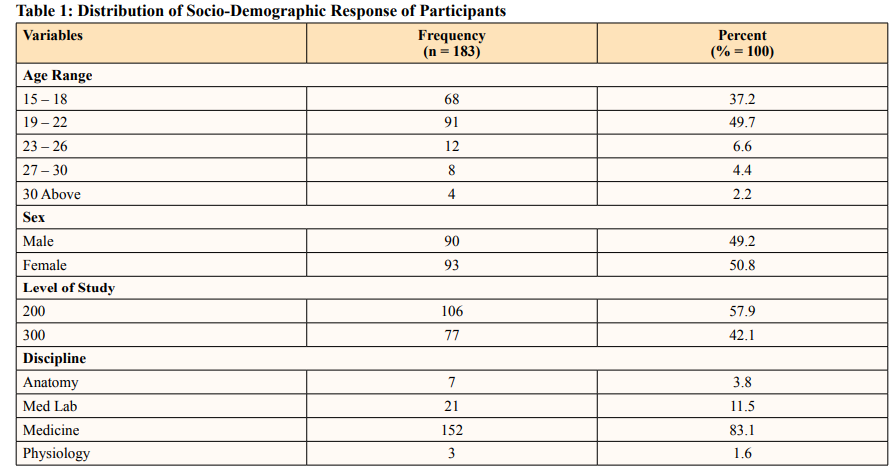

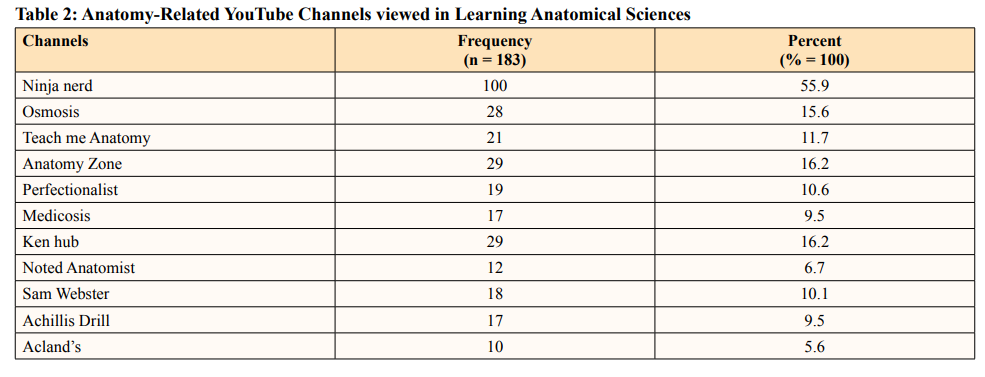
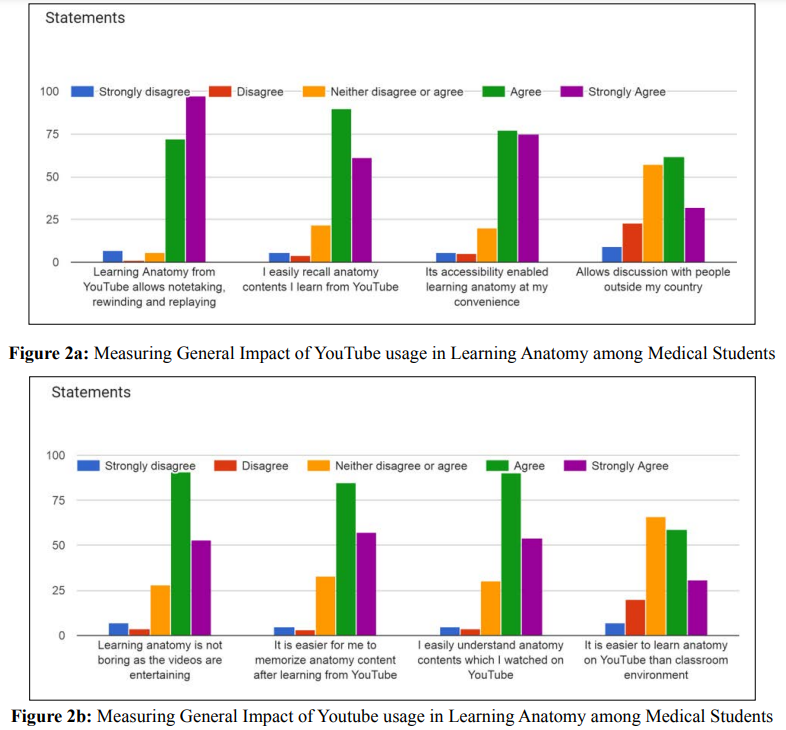
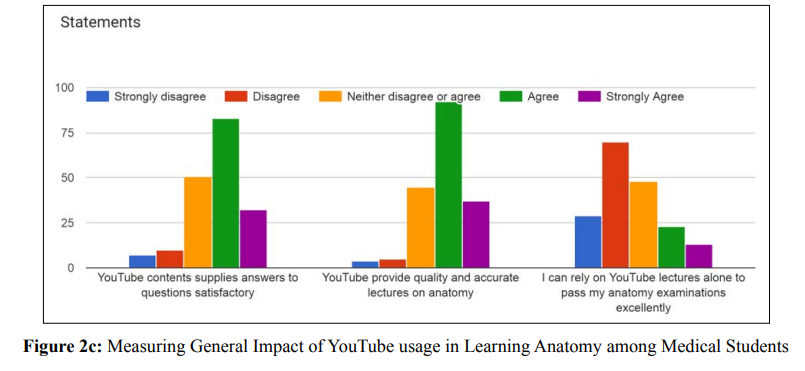
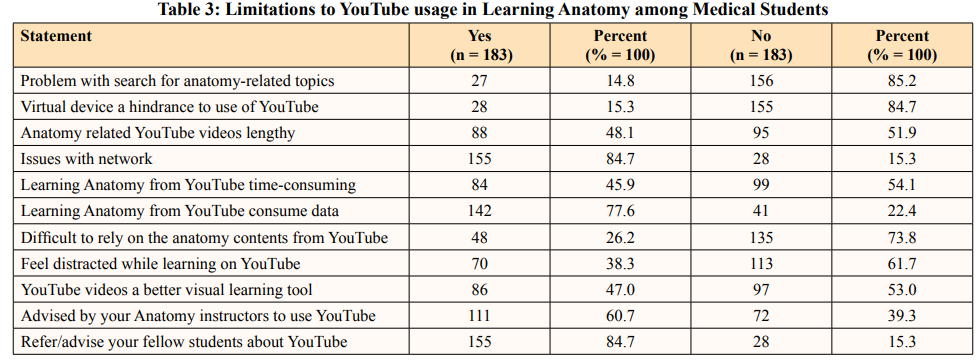
The findings of this study add to the existing literature on the use of YouTube in anatomy learning from a Nigerian medical student’s perspective. In the current report, the statistics of this study in Table 1 show the mean age of medical students in our study was 19.72 years, which is within the age range of students in the university in the Nigerian educational system [16]. Female students (50.8%) were slightly more than male students (49.2%). This shows that females were not deprived of the opportunity to study medical courses.
90.7% (Figure 1) of the EDSU medical students who responded to the survey pointed out that they use YouTube as an online information source to study human anatomy. In harmony with a previously published study, our results substantiate the broad popularity of YouTube as an online video platform [17]. The remarkably high percentage of students who reported using YouTube assures that the term “YouTube Generation” is well-earned.
Regarding the sort of anatomy-related channels on YouTube medical students views in learning anatomy, the findings in this study revealed that the majority of the students view Ninja Nerd, Ken Hub, Anatomy Zone, Osmosis, and Teach Me Anatomy and the least is Acland’s anatomy-related channel (Table 1). This indicates that students also use YouTube on their mobile phones for study and learning purposes. According to a recent study by Zargaran et al, the large percentage of students who own a smart device sheds light on why the number of students relying on e-resources and applications for learning anatomy is increasing [18]. This could be because those channels can be easily accessed and have the required anatomical contents.
Furthermore, 72.1% of medical students surveyed favored the use of YouTube to learn gross anatomy, and only 21.3% of them used it in learning histology (Figure 3). This could be explained by the fact that, although both are visual sciences, a solid understanding of gross anatomy requires more three-dimensional (3D) imagery. In contrast, visualizing two-dimensional histological slides is more important for understanding histology. As a result, one can assume that labeled images, real histological slides, and virtual microscopy are more beneficial for learning histology than videos [17]. The findings also revealed that 34.4% of the students utilized it to study neuroanatomy and embryology. Students may find it difficult to visualize the concurrent stages of embryological development because embryology is an anatomical discipline. And so, it is anticipated that using visual resources, such as YouTube videos, will improve learning.
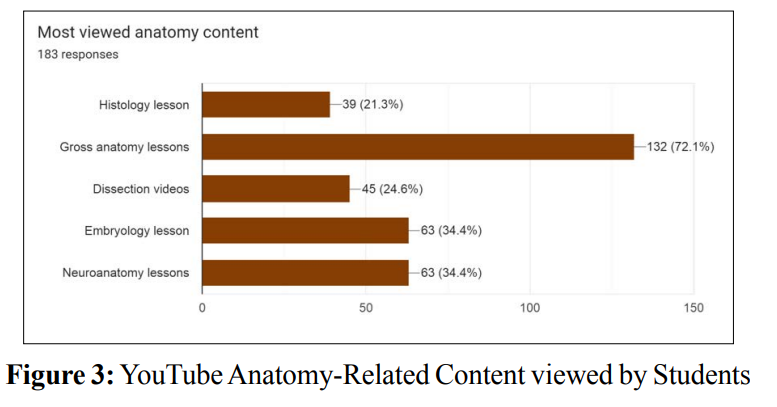
study neuroanatomy. This may be a reflection of the student’s perceptions of the difficulty of these courses and accordingly, the need for using additional educational resources such as YouTube videos, to learn the anatomy of their pathways and structures.
However, 24.6% of the students view dissection lessons on YouTube (Figure 2). This runs counter to prior research that suggests students enjoy watching dissection videos [17,19]. New developments in the study of human anatomy have not altered medical students’ perceptions of the value of anatomical dissection lessons, according to other research [15,17]. However, consideration should also be given to the fact that it can be challenging to get enough cadavers to meet educational requirements in medical schools. Medical colleges all around the world are struggling with a cadaver shortage [20,21]. In Nigeria, the dissection of human cadavers is still an essential teaching method to learn human anatomy.
In this present study, YouTube technology made it easier for students to remember anatomy courses. In this study which aimed to ascertain the impact of anatomy-related YouTube videos in anatomy education, more than two-thirds of the students agreed and strongly agreed to statement 2. Additionally, studies by Choi- Lundberg, et al. and Strkalj et al, were of the positive opinion that using dissection videos by students had improved grades [22,23]. However, a different study by Mahmud, et al. found results that were counter to their assertion [24].
The student’s response to statement 3 - “Anatomy-related YouTube videos accessibility enabled learning anatomy at my convenience” is not surprising. Taking into consideration the availability of mobile phones and the continuous study available in this tertiary institution. This observation has also been noted in another studies [25-27]. Older studies reported that the use of YouTube should be considered as a supplement tool in Anatomy education, moreover, the student’s response to statement 8 - “It is easier to learn anatomy on YouTube than classroom environment” seems to support these findings as 66 students gave a neutral response, another 59 students agreed, 20 students disagreed and 7 strongly disagreed [6,28].
Several articles showed that the use of virtual technology increases students’ ability to learn, this present study is not in tandem with their studies [25,29,30]. Reviewing students’ responses to statement 11 which states that “I can rely on YouTube lectures alone to pass my anatomy examinations excellently”, 70 students disagreed, another 29 strongly disagreed, and 48 gave neutral responses.
Students seem to have a very positive attitude toward YouTube as an anatomy-learning tool. High percentages of students responding to statements 6 and 7 that they discovered relevant anatomy-related content on YouTube and that using such information helped them understand memorize, and recall anatomical lessons are evidence of this. As perceived by students, studying anatomy well requires a variety of arrangements of memorization, comprehension, and visualization [17,31]. It’s been argued that watching films can help these mental processes. This assertion is supported by research findings that show videos posted to anatomy YouTube channels can assist viewers create memorable visual images [17,32].
Furthermore, most of the students’ feedback on possible challenges they face while learning anatomy through YouTube was “Learning Anatomy on YouTube consumes data” (142, 77.6%), “poor internet network” (155, 84.7%), “Anatomy-related YouTube videos are lengthy” (88,48.1%). Similar challenges have been briefly observed in earlier studies [25].
Lastly, although only 60.7% of students were advised by their Anatomy instructors to use YouTube in anatomy learning, 84.7% were willing to advise their colleagues to use this platform. Indeed, the latter percentage reflects an excellent learners’ satisfaction with YouTube as an anatomy-learning tool [17]. YouTube videos are a great resource for learning Anatomy. However, 73.8% of students gave a “NO” response to “Difficult to rely on the anatomy contents from YouTube”. Indeed, YouTube anatomy-related videos are of variable quality and are accordingly of a variable educational value. Anatomy educators create anatomy YouTube channels and provide their students with links that meet the course objectives and match the student’s level of knowledge this correlate with Ayman, et al. suggestions that educators should adopt YouTube as an educational tool in their anatomy instruction and to create new anatomy-related YouTube videos to enhance their students’ learning [17].
Conclusion
Anatomical information that can be successfully utilized in clinical practice can be cultivated through the use of YouTube. This study concludes that YouTube anatomy-related videos are learning resources that medical students can easily access and use successfully to learn anatomy. The comments of medical students were extremely positive and encouraging toward using this platform in augmenting their anatomy learning, and as perceived by the majority of them. YouTube videos are beneficial in anatomy education as they can potentiate recall, understanding, and memorization of anatomical information leading to achieving greater success in medical education. YouTube anatomy-related content is increasing; educators are creating new contents that fully exploit the potential offered by YouTube. Anatomists never hesitate to update their channels since it piques students’ interest in the subject and helps them study anatomy in a way that is useful, fun, and memorable. This study has some limitations, despite being instructive on using YouTube to learn anatomy. Before incorporating YouTube as a teaching tool in the anatomy curriculum, more investigation is required to identify all potential applications. In addition, the proposed usefulness of creating anatomy YouTube channels and its effect on EDSU medical students’ satisfaction with YouTube as an educational tool has to be tested. Moreover, the perspectives of anatomy educators on using this platform as an instructional tool need to be also investigated.
Data Availability
The datasets used and/or analyzed during the current study are available from the corresponding author on reasonable request.
Acknowledgment
The authors are grateful to God, the preclinical medical students and the management of Edo State University, Uzairue, Nigeria for making this study possible.
Conflict of Interest
Authors declare that they do not have any conflict of interest.
References
- Buckenmeyer JA, Barczyk C, Hixon E, Zamojski H, Tomory A (2016) Technology’s role in learning at a commuter campus: the student J Furth High Educ 40: 412-431.
- Yammine K, Violato C (2015) A meta-analysis of the educational effectiveness of three-dimensional visualization technologies in teaching Anat Sci Educ 8: 525-538.
- Ghosh SK (2017) Cadaveric dissection as an educational tool for anatomical sciences in the 21st century. Anat Sci Educ 10: 286-299.
- Singh R, Yadav N, Pandey M, David GJ (2022) Is inadequate anatomical knowledge on the part of physicians hazardous for successful clinical practice?. Surg Radiol Anat 44: 83-92.
- Kumar R, Singh R (2020) Model pedagogy of human anatomy in medical Surg Radiol Anat 42: 355-365.
- Barry DS, Marzouk F, Chulak-Oglu K, Bennett D, Tierney P, et al. (2016) Anatomy education for the YouTube generation. Anatomical Sciences Education 9: 90-96.
- Baratz G, Wilson-Delfosse AL, Singelyn BM, Allan KC, Rieth GE, et al. (2019) Evaluating the Anatomage Table Compared to Cadaveric Dissection as a Learning Modality for Gross Med Sci Educ 29: 499-506.
- Astuti L, Wihardi Y, Rochintaniawati D (2020) The Development of Web-Based Learning using Interactive Media for Science Learning on Levers in Human Body J Sci Learn 3: 89-98.
- Farag M, Bolton D, Lawrentschuk N (2019) Use of YouTube as a Resource for Surgical Education-Clarity or Confusion. European urology focus.
- Cayari C (2018) Connecting music education and virtual performance practices from YouTube. Music Education Research 20: 360-376.
- Rangarajan K, Begg K, Somani B (2019) Online digital media: The uptake of YouTube-based digital clinical education (DCE). American journal of distance education 33: 142-150.
- Rapp AK, Healy MG, Charlton ME, Keith JN, Rosenbaum ME, et al. (2016) YouTube is the most frequently used educational video source for surgical preparation. Journal of surgical education. 73: 1072-1076.
- Masters K, Ellaway RH, Topps D, Archibald D, Hogue RJ (2016) Mobile technologies in medical education: AMEE Guide 105. Medical Teacher. 38: 537-549.
- Hulme A, Strkalj G (2017) Videos in anatomy education: history, present usage and future prospects. Int J Morphol 35: 1540-1546.
- Reveron RR (2016) The use of YouTube in learning human anatomy by Venezuelan medical students. MOJ Anat & Physiol 2: 00075.
- Owolabi JO, Fabiyi SO, Ogunbiyi OE, Ayorinde FO (2020) Anatomy Education in Nigeria: An Empirical Study of Students’ Knowledge and Perceptions on Training and Prospects Towards Meeting the Country’s Need. Advances in Medical Education and Practice 11: 321-334.
- Mustafa AG, Nour RT, Othman AA, Alsalem M, Mohammed IM (2020) Using YouTube to Learn Anatomy: Perspectives of Jordanian Medical Students. BioMed Research International 1-8.
- Zargaran A, Turki MA, Bhaskar J, Spiers H, Zargaran D (2013) The role of Technology in Anatomy Teaching: Striking the Right Advances in Medical Education and Practice. 11: 259-266.
- Sanchez-Diaz PC (2013) Impact of interactive instructional tools in gross anatomy for optometry students: a pilot Optometric Education 38: 100-105.
- Biasutto SN, Namita S, Andreas HW, Fernando MB, Jennifer MB, et (2014) Human bodies to teach anatomy. Importance and procurement-Experience with cadaver donation. Part II. Rev Arg de Anat Clin 6: 162-175.
- Biasutto SN, Sharma N, Andreas W, Krishnan S (2014) Human bodies to teach Importance and procurement- Experience with cadaver donation. Rev Arg de Anat Clin 6: 72-86.
- Choi-Lundberg DL, Cuellar WA, Williams AM (2016) Online dissection audio-visual resources for human anatomy:Undergraduate medical students’ usage and learning outcomes. Anat Sci Educ 9: 545-554.
- Strkalj G, Hulme A, El-haddad J, Luo K, Crafford D, et (2018) Students’ perception and usage of short anatomy videos: A preliminary study. Int J Morphol 36: 493-499.
- Mahmud W, Hyder O, Butt J, Aftab A (2011) Dissection videos do not improve anatomy examination scores. Anat Sci Educ 4: 16-21.
- Chukwu JA, Vidona WB (2022) The Outcome of Utilising Virtual Learning Environment in Anatomy Learning: A Perspective of Preclinical Medicine Students in Edo State European Journal of Medical and Health Sciences 4: 93-98.
- Barbuceanu CD (2020) Visual Teaching - Using Digitalized Material to Engage ESP Revista de Stiinte Politice 67: 36-44.
- Alverson DC, Saiki Jr SM, Kalishman S, Lindberg M, Mennin S, et al. (2008) Medical students learn over distance using virtual reality Simul Health 3: 10-15.
- George WM, Thomas LL (2016) Anatomy education for the YouTube generation: Technical, ethical, and educational Anatomical Sciences Education 9: 496-497.
- Karbasi Z, Niakan SR (2020) Application and evaluation of virtual technologies for anatomy education to medical students: A Med J Islam Repub Iran 34: 163.
- Martin-Gutiérrez J, Mora CE, Añorbe-Díaz B, González- Marrero A (2017) Virtual technologies trends in Education. EURASIA J Math Sci and Tech Ed 13: 469-486.
- Pandey P, Zimitat C (2007) Medical students’ learning of anatomy: memorisation, understanding and visualisation, Medical Education 41: 7-14.
- Jaffar AA (2012) YouTube: an emerging tool in anatomy Anatomical Sciences Education 5: 158-164.

